Novena
colored pencil and watercolor
2019
The novena is a traditional form of Roman Catholic prayer performed over nine days. Recited publicly or privately, a novena is usually directed to a particular saint or attribute of God with a personal request or petition in mind. Novenas developed their current form in 17th Century Spain and France, but are believed to have originated in the nine days between Christ’s Ascension into Heaven and Pentecost, when the disciples gathered together in prayer before receiving the Holy Spirit.
In my Novena series of nine drawings, each piece is framed by a nine-square grid to indicate the nine days of prayer. They are my petition to the saints for intervention in issues that concern me and are populated with birds and plants symbolically appropriate to each prayer. |
| |
| Novena to the Holy Spirit for Inspiration |
| |
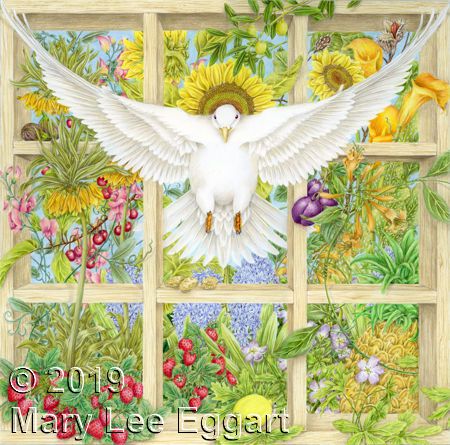 |
In Christianity, the Holy Spirit is the creative process of God and so as I began the Novena drawings, I called upon the Holy Spirit for inspiration.
Accompanying the traditional representation of the Holy Spirit as a white dove are symbols of the Seven Gifts of the Spirit bestowed upon us at our baptism: (Wisdom/Sunflower, Understanding/Flame Vine, Counsel/ Hyacinth, Fortitude/Sweet Pea, Knowledge/ Flame Calla Lily, Piety/Wild Geranium, Fear of the Lord/Crown Imperial Flower) as well as symbols of the Nine Fruits of the Spirit that bud forth in our lives when we work to develop the Gifts (Charity/Fig, Joy/Lemon, Peace/Olive, Patience/Almond, Kindness/Pineapple, Goodness/Cherry, Faithfulness/Plum, Gentleness/Strawberry, Self-control/Beechnut). |
| |
Novena to St. Maximilian Kolbe for Asylum Seekers |
| |
|
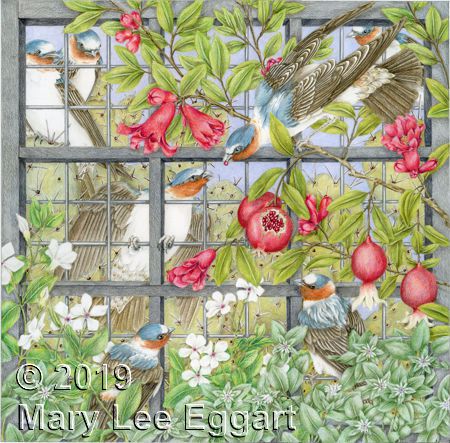 |
Maximilian Kolbe was a Polish Franciscan priest who helped over 2000 Jews hide from Nazi persecution. Arrested by the Gestapo and sent to Auschwitz, he ministered to his fellow inmates, eventually volunteering to die in place of another prisoner. He is a patron saint for all seeking asylum from persecution, injustice, and violence.
Cliff swallows are long-distance migrants, traveling between North and South America twice a year in a 3-month journey.
The grid in the drawing is an iron fence, representing the physical and societal barriers we sometimes place in the way of those seeking our help.
In front of the fence are periwinkles, a symbol of friendship, and American starwort which signifies welcome to the stranger. The opened pomegranate represents Christian charity which is open to all. Behind the fence the cactus symbolizes the harsh
conditions that the asylum seeker endures and the arduous journey he makes in hopes of a better life.
One cliff swallow offers a pomegranate seed to another in hopes of overcoming the barrier between them.
|
| |
| Novena to the Holy Innocents for the Protection of Children |
| |
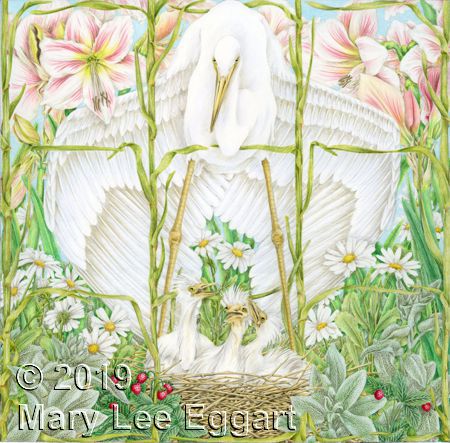 |
The Gospel of Matthew tells the story of King Herod, who in his frustration at not being able to find the baby Jesus, whom he considered a threat to his authority, ordered the massacre of all baby boys in Bethlehem under two years of age. We call on the Holy Innocents to protect all abused, neglected, and abandoned children.
The white egret fiercely protects her young in the nest. Lamb's ear plants, daisies, and strawberries are traditional symbols of innocence. St. Joseph, represented by the St. Joseph lily, protected the Christ Child and is the patron protector of all children.
The grid is formed from cordgrass, native to the marshes where the egret nests. |
|
| Novena to St. Mary Magdalene for Women's Voices to Be Heard |
| |
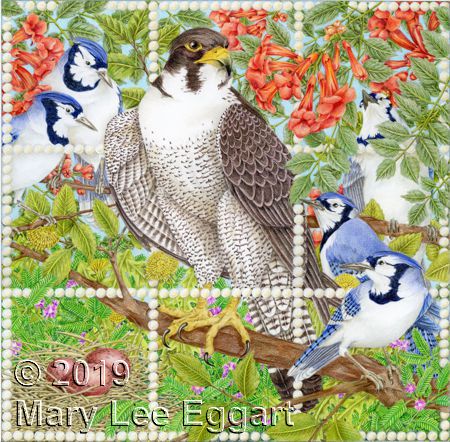 |
Mary Magdalene, often called the Apostle to the Apostles, was the first person to see the risen Christ and give witness to His resurrection. As is sadly still too often the case, the veracity of her testimony was questioned because she was a woman.
The peregrine falcon is a symbol of the courageous Christian convert casting away old ways to take on a new life, as Mary Magdalene did when she began to follow Jesus. The falcon also lays red eggs, a symbol identified with Mary Magdalene because of her association with the resurrection: early Christians dyed eggs red at Easter to mimic the blood Christ shed.
In some Native American lore, the blue jay was honored for its talkative boldness and, because it was the color of the sky, it was a symbol of clarity and truthfulness.
The touch-me-not plant refers to John 20:17 and the phrase Jesus spoke to Mary Magdalene when she first encountered Him after the resurrection. The trumpet vine represents the courage to speak truth to power. The dandelion also represents courage. The oak tree represents strength, courage, and power.
Pearls, which form the grid, are symbols of tears. Here they represent both the tears of repentance shed by Mary Magdalene and the tears of grief and frustration shed by women whose voices have not been heard or believed. |
| |
| Novena to St. Hildegard Von Bingen for Mother Earth |
| |
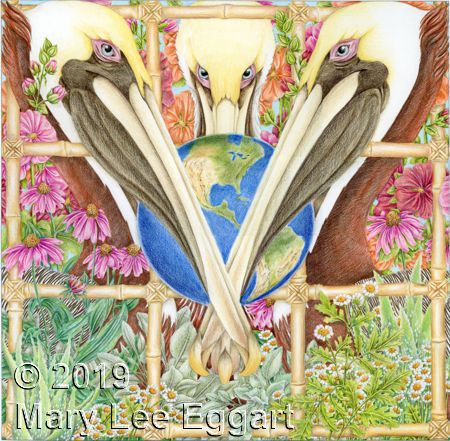 |
A German Benedictine abbess of the 12th century, Hildegard Von Bingen was a writer, philosopher, mystic, and visionary. She is considered by some to be the founder of natural history in Europe. She wrote many theological, botanical, and medicinal texts. Her views on nature and our relationship with it make her a perfect patron to protect Mother Earth, whom we have treated so badly. “If we fall in love with creation deeper and deeper, we will respond to its endangerment with passion.”
The pelican, believed in medieval times to give its own life’s blood to protect and nourish its young, is a symbol of protection. The three brown pelicans which shelter our planet are surrounded by medicinal and healing plants such as Hildegard would have used: hollyhock, feverfew, aloe, coneflower, and sage.
The grid is formed of bamboo. Among its many symbolic meanings in Chinese culture are flexibility, resilience, and harmony between people and nature. |
| |
| Novena to St. Gobnait for the Bees |
| |

A nun in 5th or 6th century Ireland, Gobnait was a beekeeper for the convent in which she lived and used honey for the treatment of illness and healing of wounds. Legends say that she also drove off invaders by releasing bees from her hives to attack them.
Honeybees are essential to at least a third of the food we consume. Multiple causes—disease, pollution, pesticides, habitat destruction—have resulted in an alarming decrease in their numbers over the past decade. Their disappearance would radically change life as we know it in very part of our planet.
The beehive in the drawing is surrounded by some of the plants the bees love best: clover, bee balm, and honeysuckle. |
| |
Novena to St. Francis of Assisi for Guidance in the Climate Crisis |
| |
 |
Francis of Assisi, an Italian friar of the 12th century, believed that nature was the mirror of God and that people must protect and enjoy nature both as stewards of God’s creation and as creatures ourselves. Thus, we turn to him for help as the climate of our planet changes and we experience increasingly extreme weather events.
Various flora and fauna named for weather phenomena populate the drawing: flame bowerbirds, red-hot poker plants, hurricane lilies, snowdrops, thunder-and-lightening plants, Grecian wind flowers, and a volcano hummingbird. The crumbling masonry of the grid emphasizes the urgency of the problem. |
|
| Novena to St. Moses the Black for Non-Violence |
| |
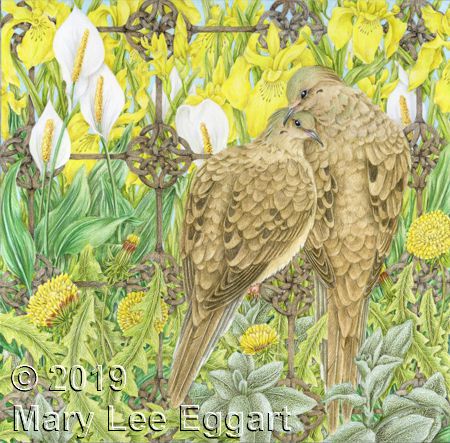 |
Moses the Black was an Ethiopian of the 4th Century who, in his early life, was known as a ruthless, cruel, and violent robber. On one occasion while attempting to escape the authorities, Moses hid among a colony of desert monks near Alexandria, Egypt. He was deeply impressed with the dedication, contentment, and peace of their lives and soon gave up his old way of life to join them. Although he continued to struggle to control his anger and violent tendencies, he learned kindness, generosity, and hospitality. We pray to him to help us do the same.
Doves are traditional symbols of peace; these mourning doves represent both non-violence and mourning for the victims of violence.
The dandelions and lamb’s ear plants represent the lion and the lamb lying down together in a peaceable kingdom. Peace lilies are joined by yellow flag iris: in classical mythology, Iris was the goddess of the rainbow. In Christianity the rainbow is a sign of peace. Therefore, the iris flower symbolizes Christ as the messenger of God who brings peace to the earth.
The Celtic knots that form the grid represent the interdependence and interconnection of all things: if one is hurt, all are hurt.
|
| |
| Novena to St. Teresa of Calcutta for Humility and Compassion |
| |
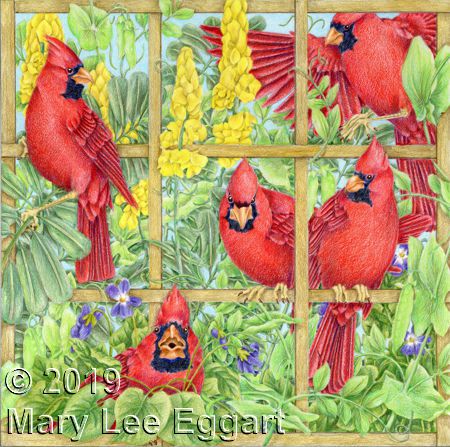 |
Mother Teresa, a native of Albania, devoted her life to serving the poorest of the poor in India and around the world. She founded the Missionaries of Charity, a religious congregation devoted to helping those in extreme need. “Not all of us can do great things. But we can do small things with great love.” Pride is the root of all sin, leading us away from love of neighbor, so we pray to Mother Teresa for humility to lead us back to compassion.
The red color of the cardinals represents love and compassion. The candle plant brings to mind lighted candles: in giving light the candle is consumed in the same way as a kind person wears himself out in service to others. The wild violet plant which grows in hidden places and the pea plant climbing the trellis that forms the grid represent humility.
|
|
| |
©2019 Mary Lee Eggart
All images and text in this site are protected by copyright law and may not be reproduced in whole or part
without the express written permission of the artist.
|
|

